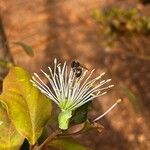Shrub or small tree, up to 7 m. high, or rarely a dwarf shrub, 15–25 cm. high, with tuberous roots.. Stems branched or several slender unbranched stems arising from the thickened rootstock, smooth or rough with light grey fissured bark.. Leaves glabrous, 3–1-foliolate or with simple leaves intermixed; petioles 4–68 mm. long, striate, spiculate or minutely punctiform; petiolules wrinkled, papillose or minutely punctiform; leaflets elliptic, ovate, obovate, linear to lanceolate or oblanceolate, 3–10 cm. long, 0.6–5.3 cm. wide, with a somewhat revolute margin, sometimes undulating, coriaceous.. Inflorescence a terminal l–20(or more)-flowered loose corymbose raceme; pedicels bracteate, articulated at the base, 1–2.1 cm. long.. Buds 7–14 mm. in diameter prior to rupture.. Stamens spreading, wavy, up to 3.6 cm. long; anthers about 3 mm. long.. Fruits ellipsoid, 3–6 cm. long, stipitate, prominently costate with up to 12 ribs.
A shrub or tree. It can grow up to 7 m high. It loses its leaves during the year. The leaves are alternate and compound. There are 3 leaflets. The leaflets are 3-9 cm long by 1-5 cm wide. The edges of the leaves are rolled under. The leaves are dark green and leathery. The flowers are large and white. The fruit are like cucumbers. They have 12 ridges along them. They are 6 cm long.
Shrub or scrambler, up to 3 m high. Calyx rupturing transversely, 'cap' often remaining attached on one side. Stamens many, on a columnar androphore. Flowers white.


